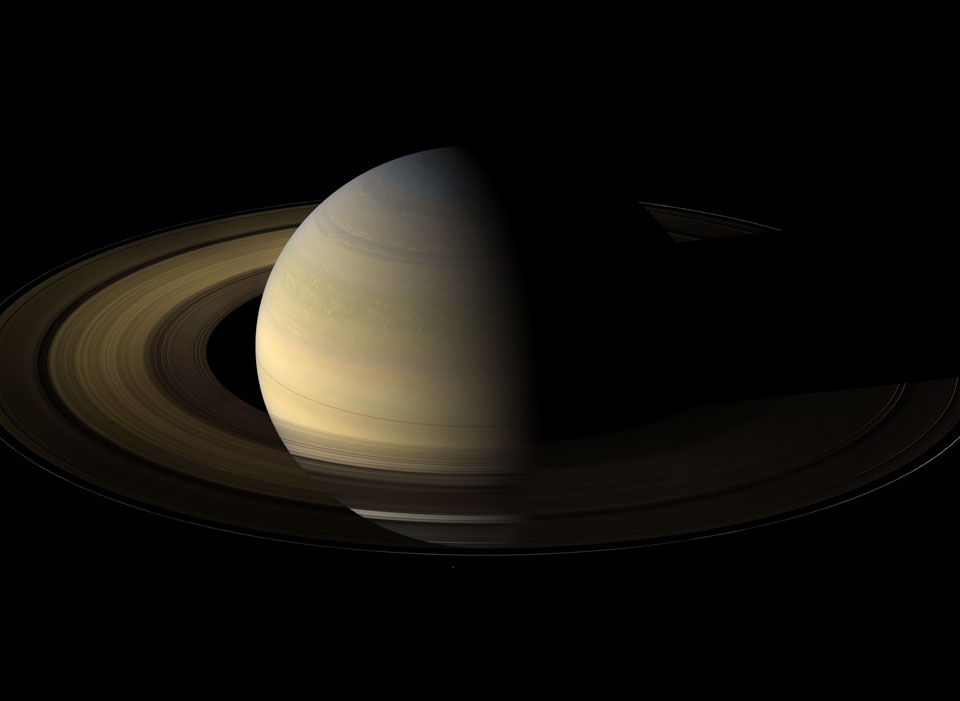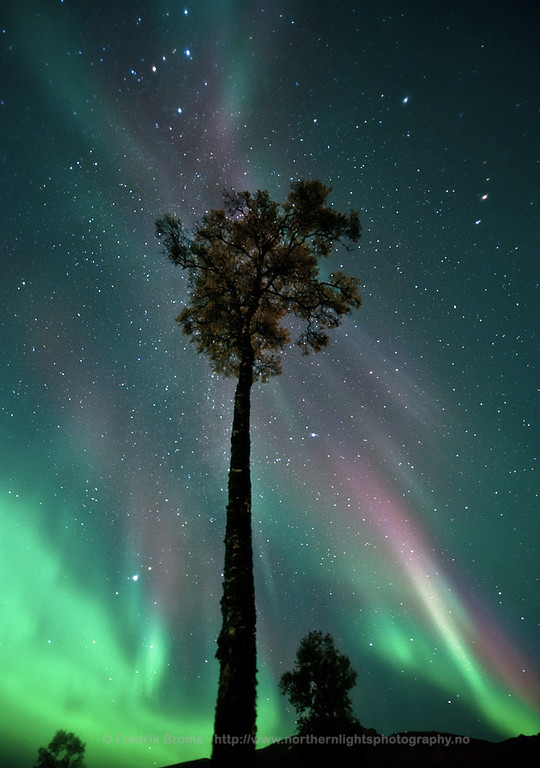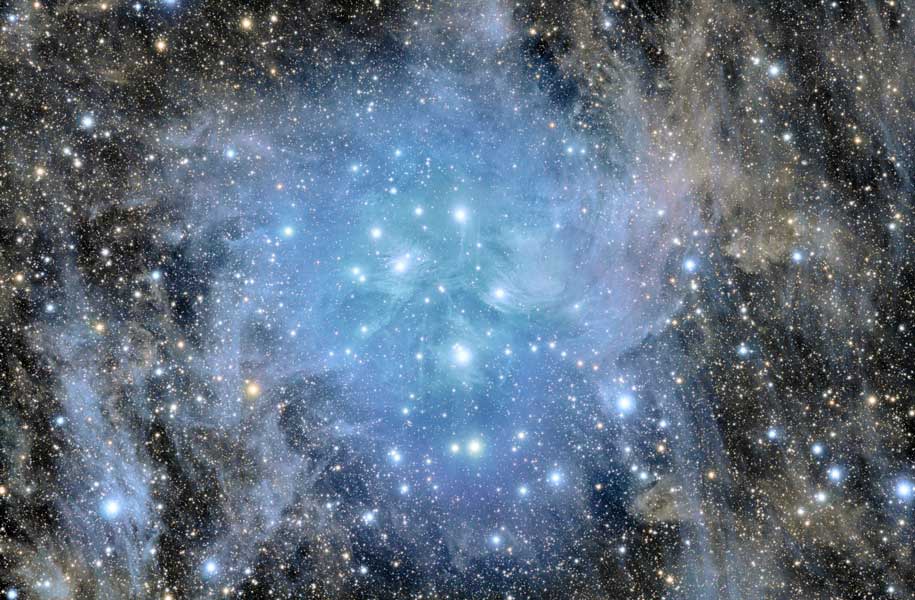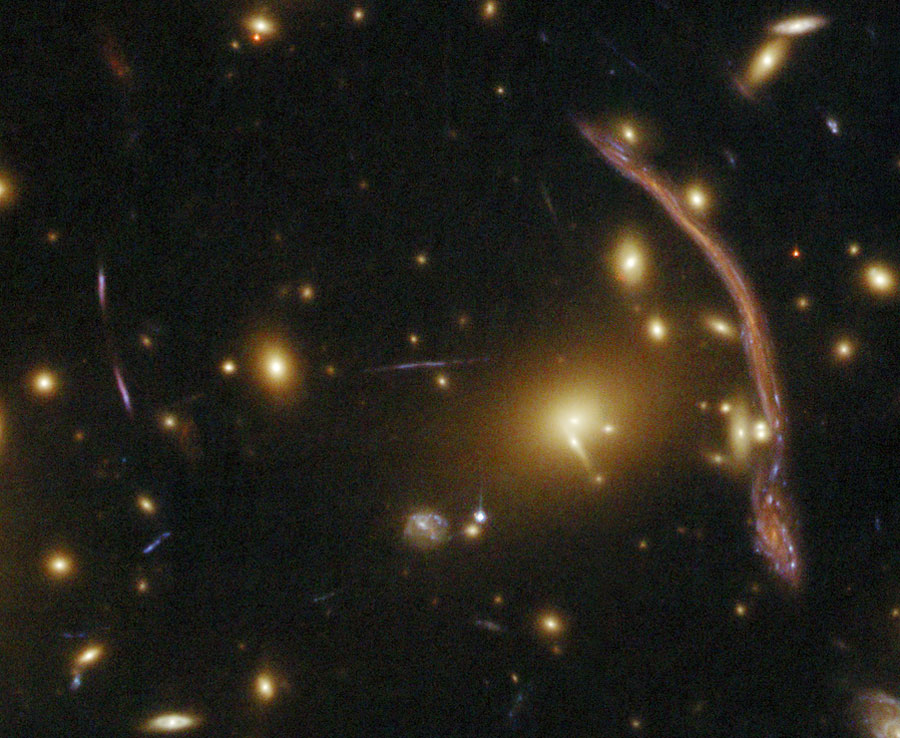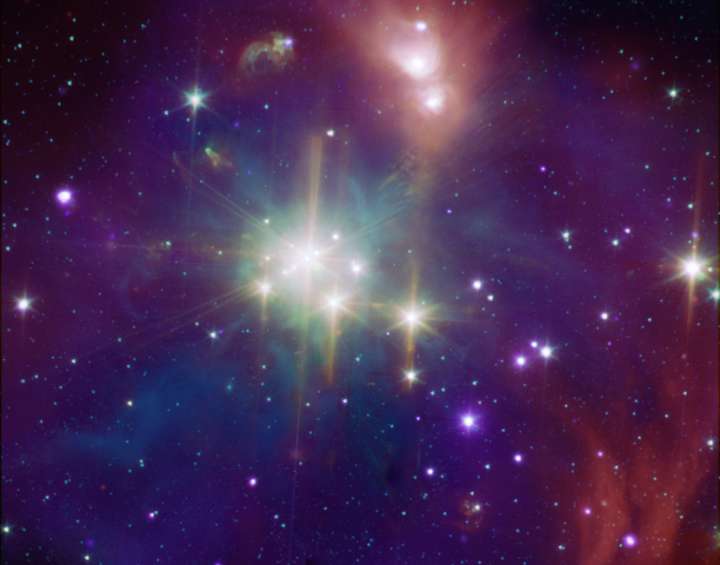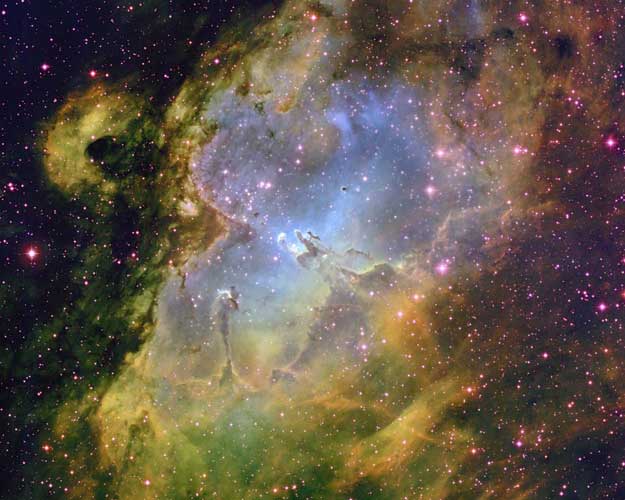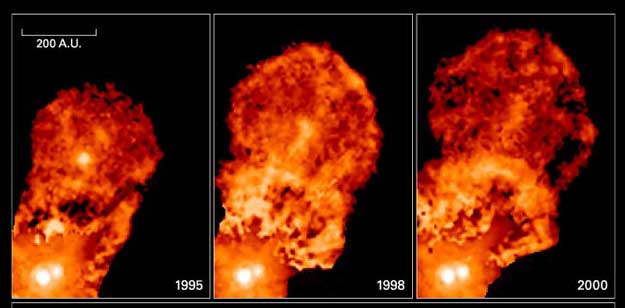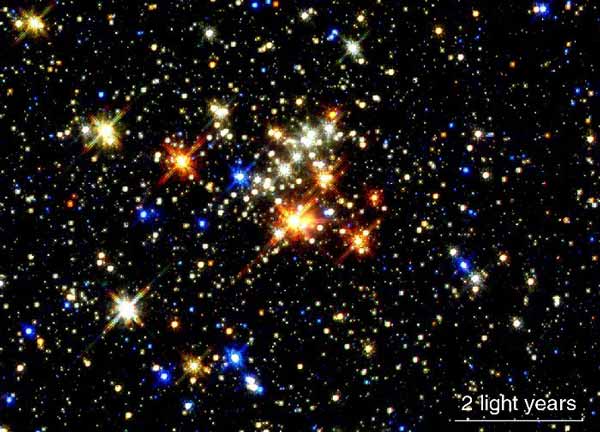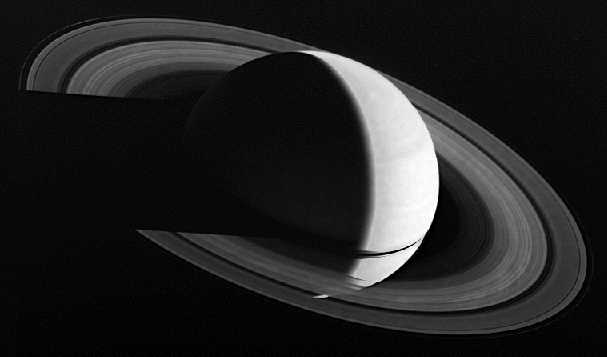| << Previous | Index | Next >> |
2015 Dust lanes seem to swirl around the core of Messier 96 in this colorful, detailed portrait of the center of a beautiful island universe. Of course M96 is a spiral galaxy, and counting the faint arms extending beyond the brighter central region, it spans 100 thousand light-years or so, making it about the size of our own Milky Way. M96, also known as NGC 3368, is known to be about 35 million light-years distant and a dominant member of the Leo I galaxy group. The featured image was taken by the Hubble Space Telescope. The reason for M96's asymmetry is unclear -- it could have arisen from gravitational interactions with other Leo I group galaxies, but the lack of an intra-group diffuse glow seems to indicate few recent interactions. Galaxies far in the background can be found by examining the edges of the picture.
2014 How would Saturn look if its ring plane pointed right at the Sun? Before August 2009, nobody knew. Every 15 years, as seen from Earth, Saturn's rings point toward the Earth and appear to disappear. The disappearing rings are no longer a mystery -- Saturn's rings are known to be so thin and the Earth is so near the Sun that when the rings point toward the Sun, they also point nearly edge-on at the Earth. Fortunately, in this third millennium, humanity is advanced enough to have a spacecraft that can see the rings during equinox from the side. In August 2009, that Saturn-orbiting spacecraft, Cassini, was able to snap a series of unprecedented pictures of Saturn's rings during equinox. A digital composite of 75 such images is shown above. The rings appear unusually dark, and a very thin ring shadow line can be made out on Saturn's cloud-tops. Objects sticking out of the ring plane are brightly illuminated and cast long shadows. Inspection of these images is helping humanity to understand the specific sizes of Saturn's ring particles and the general dynamics of orbital motion. This week, Earth undergoes an equinox.
2013 The sky looks dark in this scene from the Mid-Atlantic Regional Spaceport (MARS) at NASA Wallops Flight Facility, Virginia. Captured on Wednesday, September 18, an Orbital Sciences Corporation Antares rocket is leaving launch pad-0A with the Cygnus cargo spacecraft aboard. Though it looks like night, the photograph was taken at 10:58am EDT, under bright, clear morning skies, with a digital camera modified to record infrared images. The Sun itself is above and left of the picture frame, creating strong glare and internal reflections in the camera lens at near-infrared wavelengths. In the false-color presentation, the vegetation and watery reflections also take on an otherworldly pallor. Reaching orbit, the Cygnus spacecraft is now on its way to a Sunday rendezvous with the International Space Station. The spacecraft will deliver about 1,300 pounds (589 kilograms) of cargo to the Expedition 37 crew.
2012 September's equinox arrives tomorrow as the Sun crosses the celestial equator heading south. The event marks the astronomical beginning of spring in the southern hemisphere and autumn in the north. And though the connection is still puzzling, the equinox seasons bring an increase in geomagnetic storms. So as northern nights grow longer, the equinox also heralds the arrival of a good season for aurora hunters. Recorded on September 20, these colorful northern lights were captured with camera and wide-angle lens near the Norwegian Sea coast outside Tromsø in Northern Norway. Shining at altitudes of 100 kilometers or so, the aurora rays are parallel, but perspective makes them appear to radiate from a vanishing point behind the silhouetted pine tree. Stars in this enchanting northern night include Polaris above and right of the tree top, and yellowish giant stars Shedar (Alpha Cassiopiae) to the left and Kochab (Beta Ursae Minoris) to the right. Bright Altair shines through the greenish auroral curtain at the lower left of the scene.
2011 Have you ever seen the Pleiades star cluster? Even if you have, you probably have never seen it like this: all dusty. Perhaps the most famous star cluster on the sky, the bright stars of the Pleiades can be seen without binoculars from even the depths of a light-polluted city. With a long exposure from a dark location, though, the dust cloud surrounding the Pleiades star cluster becomes very evident. The above exposure took about 30 hours and covers a sky area several times the size of the full moon. Also known as the Seven Sisters and M45, the Pleiades lies about 400 light years away toward the constellation of the Bull (Taurus). A common legend with a modern twist is that one of the brighter stars faded since the cluster was named, leaving only six stars visible to the unaided eye. The actual number of Pleiades stars visible, however, may be more or less than seven, depending on the darkness of the surrounding sky and the clarity of the observer's eyesight.
2010 How can the majesty of the night sky best be captured in a painting? This was a continual challenge for Vincent van Gogh, a famous painter in the late 1800s who pioneered stirring depictions of star filled skies into several of his works. Pictured above is van Gogh's Starry Night Over the Rhone, where the French town of Arles is depicted complete with gas lights reflecting off the Rhone river. van Gogh's night sky appears alive with turbulent stellar images contrasting with lofty dark blue hues. Above the river, one can discern the stars of the familiar Big Dipper asterism. Following a line connecting the two Big Dipper stars on the right, the North Star Polaris could be easily found, the height of which can then be estimated and actually gives the latitude where the painting was created.
2009 What is that strange arc? While imaging the cluster of galaxies Abell 370, astronomers had noted an unusual arc to the right of many cluster galaxies. Although curious, one initial response was to avoid commenting on the arc because nothing like it had ever been noted before. In the mid-1980s, however, better images allowed astronomers to identify the arc as a prototype of a new kind of astrophysical phenomenon -- the gravitational lens effect of entire cluster of galaxies on background galaxies. Today, we know that this arc actually consists of two distorted images of a fairly normal galaxy that happened to lie far behind the huge cluster. Abell 370's gravity caused the background galaxies' light -- and others -- to spread out and come to the observer along multiple paths, not unlike a distant light appears through the stem of a wine glass. In mid-July, astronomers used the just-upgraded Hubble Space Telescope to image Abell 370 and its gravitational lens images in unprecedented detail. Almost all of the yellow images pictured above are galaxies in the Abell 370 cluster. An astute eye can pick up many strange arcs and distorted arclets, however, that are actually images of more distant galaxies. Studying Abell 370 and its images gives astronomers a unique window into the distribution of normal and dark matter in galaxy clusters and the universe.
2008 Tomorrow is the autumnal equinox -- should eggs be able to stand on end? This long-standing myth loses much of its mystique after a demonstration that eggs can be made to stand on end during any day of the year. Pictured above, Dr. Phil Plait, acting as the Bad Astronomer balanced three raw eggs on end in late October 1998. Later, more modestly, his wife balanced five more. The little-appreciated fact that most eggshells have small bumps on them makes this seemingly impossible task achievable. Although, during an equinox, every place on Earth experiences an equal length day and night (12 hours each), this fact has no practical effect on egg stability.
2007 X-rays from young stars and infrared light from stars and cosmic dust are combined in this false color image of a star-forming region in Corona Australis, the Southern Crown. The small star grouping is fittingly known as the Coronet Cluster. A mere 420 light-years distant, the Coronet Cluster offers a relatively close-up view of stars and protostars evolving with a wide range of masses. The observations suggest that energetic x-rays come from the hot, extended stellar atmospheres or coronae of the Coronet stars. The tantalizing multi-wavelength view spans about 2 light-years and was produced using data from the orbiting Chandra Observatory (x-ray) and the Spitzer Space Telescope (infrared).
2006 Though it's 93 million miles away, the Sun still hurts your eyes when you look at it. But bright sunlight (along with accurate planning and proper equipment!) resulted in this sharp silhouette of spaceship and space station. The amazing telescopic view, recorded on September 17, captures shuttle orbiter Atlantis and the International Space Station in orbit over planet Earth. At a range of 550 kilometers from the observing site near Mamers, Normandy, France, Atlantis (left) has just undocked and moved about 200 meters away from the space station. Tomorrow, yet another satellite of planet Earth can be seen in silhouette - the Moon will eclipse the Sun. This last eclipse of 2006 will be seen as an annular solar eclipse along a track that crosses northern South America and the south Atlantic.
2005 What could have created this unusual terrain on Saturn's moon Titan? The robotic Cassini spacecraft now orbiting Saturn swooped once again, earlier this month, past the Solar System's most enigmatic moon and radar imaged a rich but unusual region that appears to be some sort of shoreline. The choppy, light-colored, high regions on the left appears to be have channels cut by a moving fluid, while the smoother dark regions on the right appear to outline bays. Results from the Huygens probe that landed on Titan earlier this year imply that fluids, possibly liquid methane and not water, might only occupy some of these channels and bays intermittently. The radar image shown above spans about 200 kilometers.
2004 Many vast star fields in the plane of our Milky Way Galaxy are rich in clouds of dust, and gas. First and foremost, visible in the above picture are millions of stars, many of which are similar to our Sun. Next huge filaments of dark interstellar dust run across the image and block the light from millions of more stars yet further across our Galaxy. The bright red region on the left is part of the Omega Nebula, an emission nebula of mostly hot hydrogen gas also known as M17. A small bright grouping of stars near the image center is the open cluster M18, while the long bright streak of stars just right of center is M24. On the far right of the image is the picturesque red emission nebula IC 1283 flanked by two blue reflection nebulas NGC 6589 and NGC 6590. These objects are visible with a small telescope toward the constellation of Sagittarius.
2003 From afar, the whole thing looks like an Eagle. A closer look at the Eagle Nebula, however, shows the bright region is actually a window into the center of a larger dark shell of dust. Through this window, a brightly-lit workshop appears where a whole open cluster of stars is being formed. In this cavity tall pillars and round globules of dark dust and cold molecular gas remain where stars are still forming. Already visible are several young bright blue stars whose light and winds are burning away and pushing back the remaining filaments and walls of gas and dust. The Eagle emission nebula, tagged M16, lies about 6500 light years away, spans about 20 light-years, and is visible with binoculars toward the constellation of Serpens. The above picture combines three specific emitted colors and was taken with the 0.9-meter telescope on Kitt Peak, Arizona, USA.
2002 During the Astro-1 astronomy mission of December, 1990, Space Shuttle astronauts photographed this stunning view of the setting full moon poised above the Earth's limb. In the foreground, towering clouds of condensing water vapor mark the extent of the troposphere, the lowest layer of the planet's life-sustaining atmosphere. Strongly scattering blue sunlight, the upper atmospheric layer, the stratosphere, fades dramatically to the black background of space. Moon and clouds are strong visual elements of many well known portraits of planet Earth, including Ansel Adams' famous "Moonrise, Hernandez, New Mexico", photographed in 1941.
2001 Black hole candidate XTE J1118+480 is known to roam the halo of our Milky Way Galaxy. This exotic system - thought to be a stellar mass black hole consuming matter from a companion star - was discovered only last year as a flaring celestial x-ray source. Suggestively termed a microquasar, recent radio and archival optical observations of its motion through the sky have now allowed its orbit to be calculated. Illustrated above, the black hole's present galactic location is indicated by the purple dot, with the Sun's position in yellow. A mere 6,000 light-years from the Sun now, XTE J1118+480's orbit is traced by the orange line, backtracked for some 230 million years into the past based on models of the Galaxy. Astronomers note this black hole's orbit about the galactic center, looping high above and below the Galaxy's plane of gas, dust,and stars, is similar to orbits of globular star clusters, ancient denizens of our Galaxy. It seems likely that XTE J1118+480 too has its origins in the early history and halo of the Milky Way.
2000 Why is the binary star system XZ Tauri emitting a hot bubble of expanding gas? Although astronomers can only presently speculate, the Hubble Space Telescope clearly documents this unusual behavior in three dramatic photographs over the past five years. Even without knowing why, the recently released sequence shows in unprecedented clarity the beginnings of a cooling zone -- a region where the expanding gas bubble cools off by emitting light as electrons and ions meet and recombine. The XZ Tauri star system is known to reside in the Taurus star forming region located about 500 light-years away. XZ Tau is composed of two very young stars separated by roughly the same distance as between our Sun and Pluto. The bubble has been expanding over the past thirty years and now extends to nearly fifteen times the binary separation.
1999 Bright clusters of stars form and disperse near the center of our Galaxy. Four million years ago the Quintuplet Cluster, pictured above, formed and is now slowly dispersing. The Quintuplet Cluster is located within 100 light-years of the Galactic center, and is home to the brightest star yet cataloged in our Galaxy: the Pistol Star. Objects near our Galactic center are usually hidden from view by opaque dust. This recently-released picture was able to capture the cluster in infrared light, though, with the NICMOS camera onboard the orbiting Hubble Space Telescope. The young Quintuplet Cluster is one of the most massive open clusters yet discovered, but still much less massive than the ancient globular clusters that orbit in the distant halo. Some of the bright white stars visible above may be on the verge of blowing themselves up in a spectacular supernova.
1998 NGC 281 is a busy workshop of star formation. Prominent features include a small open cluster of stars, a diffuse red-glowing emission nebula, large lanes of obscuring gas and dust, and dense knots of dust and gas in which stars may still be forming. The open cluster of stars IC 1590 visible on the upper right has formed only in the last few million years. The brightest member of this cluster is actually a multiple-star system shining light that helps ionize the nebula's gas, causing the red glow visible throughout. The lanes of dust on the lower right might be the home of future star formation. Particularly striking in the above photograph are the dark Bok globules visible against the bright nebula. Stars are probably forming there right now. The entire NGC 281 system lies about 10 thousand light years distant.
1997 This picture of Saturn could not have been taken from Earth. No Earth based picture could possibly view the night side of Saturn and the corresponding shadow cast across Saturn's rings. Since Earth is much closer to the Sun than Saturn, only the day side of the planet is visible from the Earth. In fact, this photo was taken by the Voyager 1 spacecraft as it flew by Saturn in November 1980. The next spacecraft to approach Saturn will be Cassini which is currently scheduled to be launched later this year and reach Saturn in 2004.
1996 The Plane of the Ecliptic is illustrated in this Clementine star tracker camera image which reveals (from right to left) the Moon lit by Earthshine, the Sun's corona rising over the Moon's dark limb, and the planets Saturn, Mars, and Mercury. The ecliptic plane is defined as the imaginary plane containing the Earth's orbit around the Sun. In the course of a year, the Sun's apparent path through the sky lies in this plane. The planetary bodies of our solar system all tend to lie near this plane, since they were formed from the Sun's spinning, flattened, proto-planetary disk. The snapshot above nicely captures a momentary line-up looking out along this fundamental plane of our solar system.
1995 On July 20th, 1969, a human first set foot on the Moon. Pictured above is the first lunar footprint. The footprint and distinction of the first person to walk on the Moon belong to Neil Armstrong. It has been estimated that one billion people world-wide watched Armstrong's first step - making the live transmission from a camera mounted on the lunar lander the highest rated television show ever. Upon setting foot on the moon, Armstrong said: "That's one small step for (a) man, one giant leap for mankind." The Apollo missions to the Moon have been described as the result of the greatest technological mobilization the world has known.
| << Previous | Index | Next >> |

